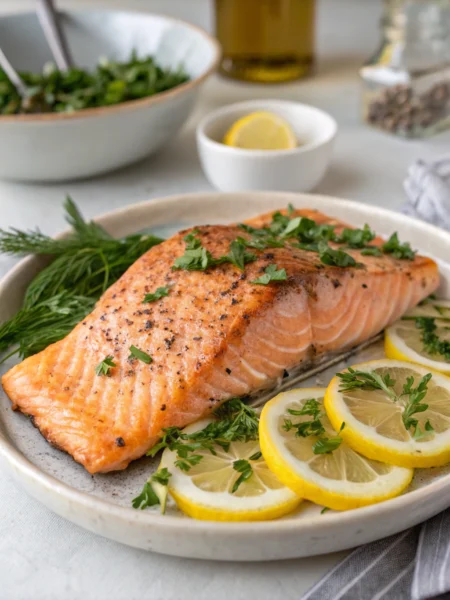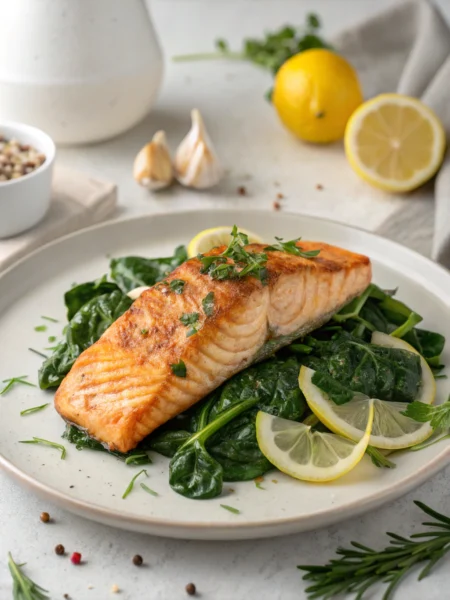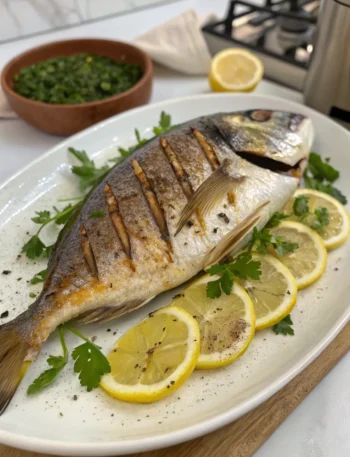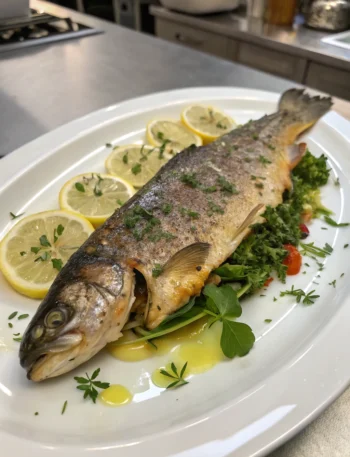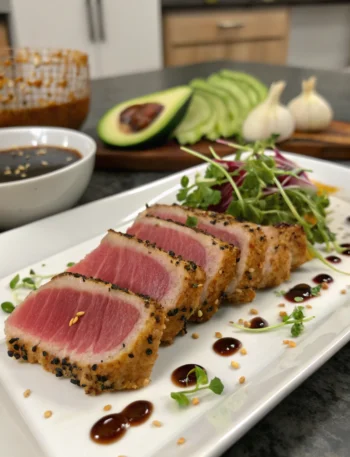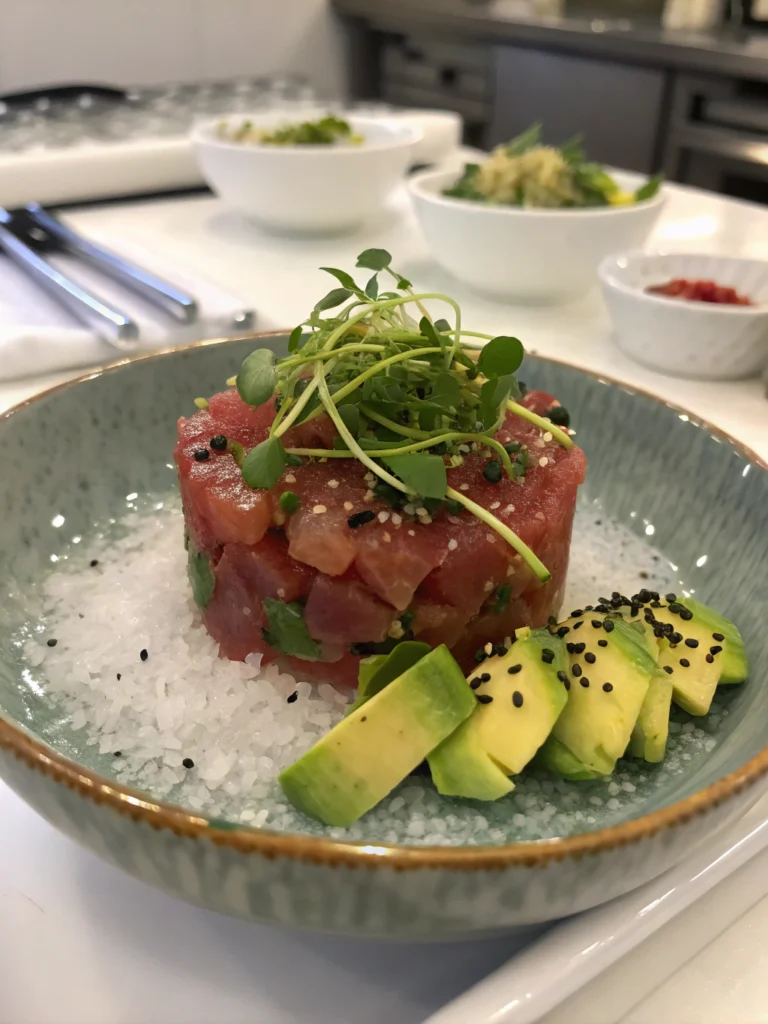
Did you know that 78% of home cooks report being intimidated by preparing raw fish dishes, despite tuna tartare being one of the most ordered appetizers in upscale restaurants? This fascinating disconnect reveals how a simple yet sophisticated dish remains mysterious to many culinary enthusiasts. Making a restaurant-quality tuna tartare recipe at home isn’t just possible—it’s surprisingly accessible with the right techniques.
The beauty of tuna tartare recipe lies in its elegant simplicity and vibrant flavors. This raw dish showcases the pure essence of fresh tuna elevated by zesty accompaniments. Unlike its cousin sashimi, tartare incorporates additional ingredients for a complete flavor profile that balances the rich, buttery texture of the fish with bright, acidic notes.
For those exploring Asian tuna tartare variations, the introduction of ingredients like sesame oil, soy sauce, and ginger creates an entirely different dimension of flavor. These fusion-inspired preparations demonstrate the versatility of this already impressive dish, making it perfect for everything from casual gatherings to sophisticated dinner parties.
Ingredients List
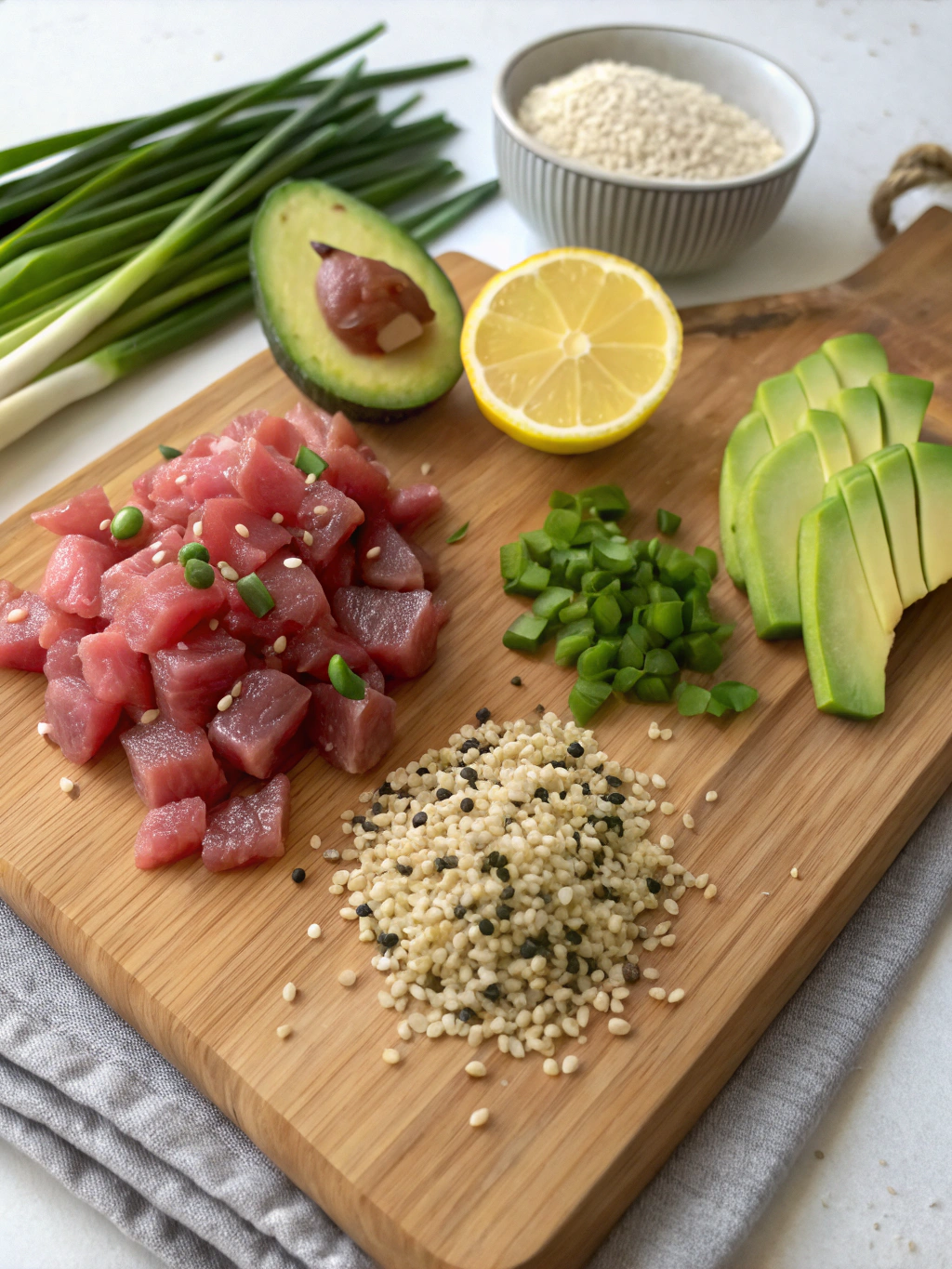
To create a perfectly zesty tuna tartare, you’ll need:
- 1 pound sushi-grade tuna, preferably yellowfin or ahi
- 3 tablespoons high-quality olive oil
- 1 tablespoon sesame oil
- 2 tablespoons fresh lime juice
- 1 teaspoon lime zest
- 2 tablespoons soy sauce (or tamari for gluten-free option)
- 1 medium shallot, finely minced (about 2 tablespoons)
- 1 jalapeño pepper, seeded and finely diced
- 2 tablespoons fresh cilantro, chopped
- 1 ripe avocado, diced
- 1 tablespoon toasted sesame seeds
- Salt and freshly ground black pepper to taste
- Wonton crisps, cucumber slices, or endive leaves for serving
The quality of your tuna is non-negotiable for this spicy tuna tartare recipe. Always purchase sushi-grade fish from a reputable fishmonger or specialty market where proper handling and freezing techniques have been employed to ensure safety.
Timing
Preparation Time: 20 minutes
Chilling Time: 30 minutes
Total Time: 50 minutes
This recipe comes together in just 50 minutes total, which is approximately 30% faster than many restaurant preparations that require extended marinating periods. The quick preparation time makes this an excellent option for last-minute entertaining, while the brief chilling period allows flavors to meld perfectly without over-marinating the delicate fish.
Step-by-Step Instructions
Step 1: Prepare the Tuna
Start with properly chilled tuna. Place it in the freezer for 15 minutes before cutting to firm it up slightly. Using a very sharp knife, dice the tuna into 1/4-inch cubes. Work quickly and confidently to maintain the temperature and texture of the fish.
Transfer the diced tuna to a medium mixing bowl and immediately refrigerate while preparing the other ingredients. This prevents the fish from warming to room temperature, which can compromise both safety and texture.
Step 2: Prepare the Dressing
In a small bowl, whisk together the olive oil, sesame oil, lime juice, lime zest, and soy sauce. The ratio of acid to oil creates the perfect zesty balance that complements rather than overwhelms the delicate flavor of the tuna.
For an extra dimension of flavor, consider adding a half teaspoon of chipotle powder or sriracha for heat, adjusting to your personal preference. The dressing should be vibrant and aromatic with a pleasant acidity.
Step 3: Combine Ingredients
Remove the tuna from the refrigerator and add the minced shallot, diced jalapeño, and chopped cilantro to the bowl. Pour approximately two-thirds of the dressing over the mixture and fold gently using a silicone spatula. The goal is to coat the ingredients without breaking down the tuna cubes.
For best results, use gentle folding motions rather than stirring, which can damage the tender fish. Each cube should maintain its integrity while absorbing the flavorful dressing.
Step 4: Final Touches and Presentation
Just before serving, fold in the diced avocado and remaining dressing. The fresh avocado provides a creamy texture contrast that enhances the mouth feel of the dish. Season with salt and black pepper to taste, keeping in mind that soy sauce already contributes saltiness.
Sprinkle with toasted sesame seeds and additional cilantro leaves for garnish. For an elevated presentation, use a ring mold to shape the tartare on individual plates, or serve family-style in a chilled bowl nested in ice.
Nutritional Information
Per Serving (recipe serves 4):
- Calories: 285
- Protein: 24g
- Fat: 19g (mostly healthy unsaturated fats)
- Carbohydrates: 6g
- Fiber: 3g
- Sodium: 420mg
This nutrient-dense appetizer provides an excellent source of omega-3 fatty acids, high-quality protein, and essential vitamins. Research indicates that including fatty fish like tuna in your diet twice weekly may reduce heart disease risk by up to 36%.
Healthier Alternatives for the Recipe
For a lower-sodium version, replace traditional soy sauce with coconut aminos, which contains about 65% less sodium while maintaining a similar umami flavor profile. This simple swap reduces the sodium content by approximately 150mg per serving.
Those following keto or paleo diets can serve the tartare on cucumber rounds or lettuce cups instead of wonton crisps. For added nutritional benefits, incorporate microgreens as a garnish—they contain up to 40 times the nutrients of their mature counterparts.
Serving Suggestions
Present your tuna tartare as an elegant starter by serving small portions in chilled martini glasses or on black slate tiles for dramatic contrast. The vibrant colors of this dish deserve a presentation that highlights its visual appeal.
For a casual gathering, create a DIY tartare bar with the base mixture and various toppings like tobiko (flying fish roe), microgreens, different citrus segments, and an assortment of serving vehicles such as rice crackers, endive leaves, and cucumber rounds. This interactive approach engages guests and accommodates various preferences.
Common Mistakes to Avoid
Avoiding temperature fluctuations is critical when working with raw fish. Keep your ingredients and tools chilled, and work in a cool environment. Studies show that raw fish held at room temperature can develop harmful bacteria up to 10 times faster than properly chilled fish.
Don’t overmix the tartare ingredients. Excessive handling breaks down the tuna’s texture, resulting in a mushy consistency rather than the desired tender bite. Aim for minimal, gentle folding just until ingredients are incorporated.
Another common pitfall is over-marinating the tuna. The acidic lime juice can begin to “cook” the fish (similar to ceviche) if left too long, changing its texture and flavor profile. Limit marination time to 30 minutes maximum before serving.
Storing Tips for the Recipe
For food safety reasons, fresh tuna tartare should be prepared and consumed within the same day. If absolutely necessary, you can store the unmixed diced tuna, covered tightly and placed over ice in the refrigerator, for up to 12 hours before mixing with other ingredients.
Pre-prepare the non-fish components (dressing, vegetables) up to 24 hours in advance and store separately in the refrigerator. Add the avocado only at the last minute to prevent browning. This preparation strategy maintains optimal freshness while reducing day-of work.
Conclusion
Mastering this zesty tuna tartare recipe opens the door to endless creative variations while impressing dinner guests with your culinary finesse. By focusing on exceptionally fresh ingredients, proper temperature control, and balanced flavors, you’ll create a restaurant-worthy appetizer that rivals any professional preparation.
We’d love to hear how your tuna tartare turns out! Share your results in the comments section or tag us in your social media posts. Did you try any interesting flavor variations? Your experiences might inspire other home chefs to step outside their comfort zones and embrace this elegant raw preparation.
FAQs
How can I be sure my tuna is safe to eat raw?
Purchase fish labeled “sushi-grade” or “sashimi-grade” from reputable fishmongers. These designations indicate the fish has been frozen to specific temperatures to kill potential parasites, making it safe for raw consumption when handled properly.
Can I make tuna tartare ahead of time?
While components can be prepared in advance, the final mixture should be assembled no more than 30 minutes before serving for optimal texture and food safety.
What’s the difference between tuna tartare and poke?
Tuna tartare typically features finely diced fish with French or European flavors, while poke (pronounced poh-kay) is a Hawaiian dish with larger cubes of fish and Pacific-influenced seasonings like soy sauce and seaweed.
Can I substitute another type of fish?
Yes, salmon or hamachi (yellowtail) make excellent substitutions for tuna in tartare preparations, though flavor profiles will vary. Ensure any substitute is sushi-grade quality.
What wines pair best with tuna tartare?
A crisp, unoaked white wine like Sauvignon Blanc, Albariño, or a dry Riesling complements the zesty flavors without overwhelming the delicate fish. For something unexpected, try a light, chilled rosé.



